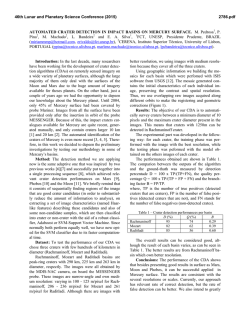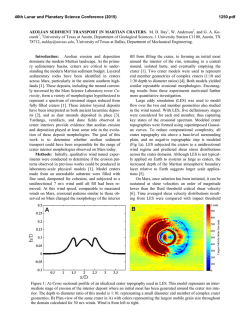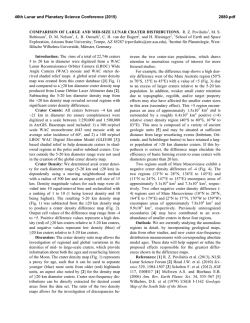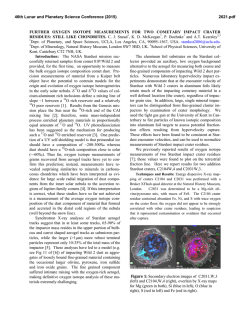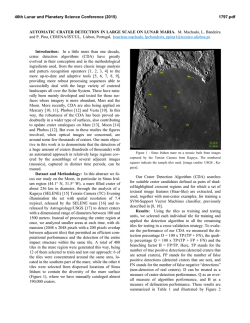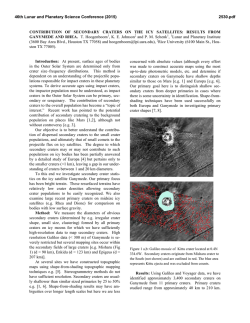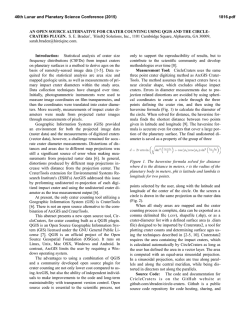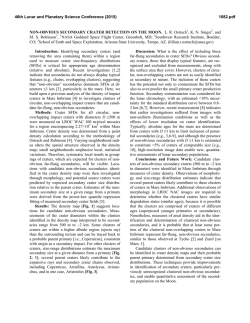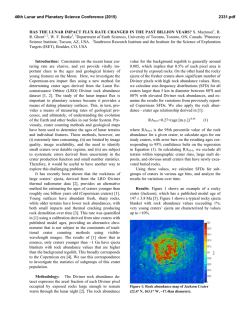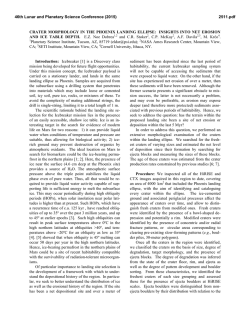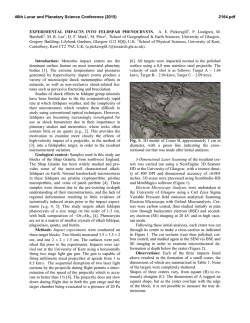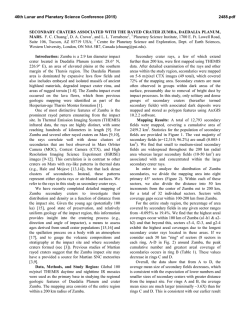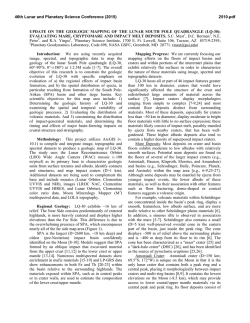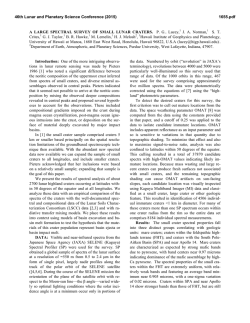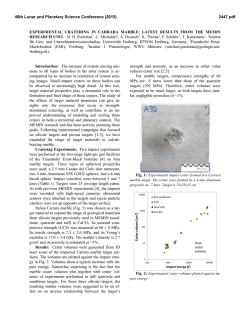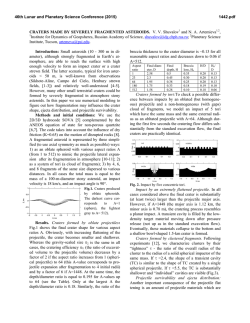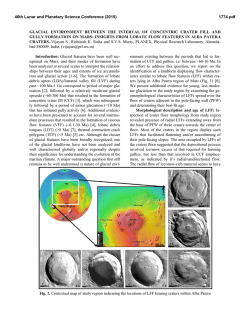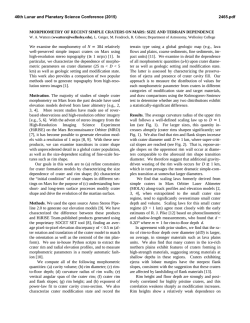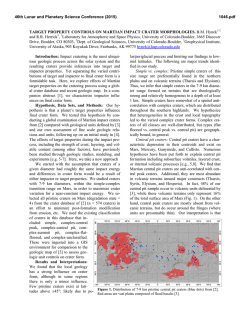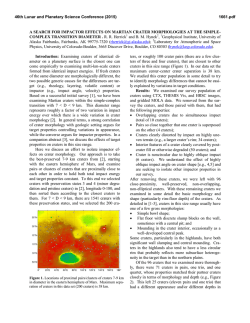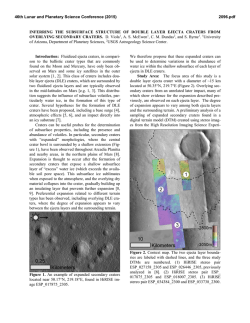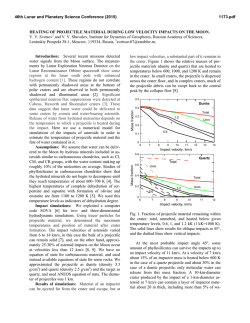
classifying martian mid-latitude post
46th Lunar and Planetary Science Conference (2015) 1625.pdf CLASSIFYING MARTIAN MID-LATITUDE POST-IMPACT CRATER FILL MORPHOLOGIES AND THEIR PRESERVATION STATES: INSIGHTS INTO CLIMATE HISTORY ON MARS. T. N. Harrison1*, G. R. Osinski1,2, L. L. Tornabene1, and D. K. Zylik1, 1Centre for Planetary Science and Exploration/Department of Earth Sciences, University of Western Ontario, 2Department of Physics and Astronomy, University of Western Ontario. (*[email protected]) Introduction: Many mid-latitude craters on Mars exhibit morphologically distinct post-impact “fill” material on their floors [e.g., 1,2]. This material is inferred to be (or have been) ice-rich based on morphological characteristics such as evidence for flow and removal, and their morphologic similarity to lineated valley fill and lobate debris aprons [e.g., 1]. These latter features possess subsurface reflectors with dielectric properties consistent with nearly pure water ice based on the Mars Reconnaissance Orbiter (MRO) Shallow Radar (SHARAD) instrument [3,4]. Morphological markers indicative of removal of this fill material over time are also consistent with a composition, either past or present, with a significant fraction of ice [5]. However, the vast majority of fill-bearing craters are too small for SHARAD to resolve the presence or absence of ice, so for the time being morphological indicators are key. Using MRO Context Camera (CTX) images, we distinguish 8 classes of mid-latitude post-impact crater fill material based on their visible morphology. These are then divided into 4 main classes and 4 states of preservation. The goal of creating such a classification scheme is to: 1) map of the distribution of the crater fill material (including outside of the mid-latitudes, as similar material has been documented in the equatorial region in Terra Sabaea [6]); 2) look for any relationships in morphology and preservation state with geographic location, and 3) see how this correlates with areas of predicted ice accumulation under higher obliquity periods based on global circulation models [e.g., 7,8]. Methods: While documenting the global distribution of gullies with MRO CTX [9], covering over 90% of Mars at a resolution of ~6 m/pixel at the time of writing, notes on mid-latitude crater-fill morphologies and preservation states were made. With an initial focus on Utopia Planitia, 2697 craters have been documented thus far, 2247 of which contain fill material and the remaining 450 free of mid-latitude fill. Results: Originally presented as 8 classes by Harrison et al. [9], this classification scheme has been refined to 4 distinct morphologies: concentric, flow, smooth, and irregular (Figure 1). These morphologies can then be broken down into four main preservation states: well-preserved, eroded/degraded, mantled, and periglacial. Fill Classes – Concentric class. This class displays the classical “concentric crater fill” (CCF) morphology [1], with ridges concentric to the crater rim. Regional mapping by Levy et al. [9] and Harrison et al. [8] show that in at least portions of the northern hemisphere, the occurrence of CCF is strongly latitude-dependent, with preference for latitudes poleward of 40°. Flow Class. This class only partially fills its host crater. It displays surficial lineations suggesting flow in a preferential direction—typically toward the pole in either hemisphere [c.f., 10,11]. Smooth Class. The surface of fill deposits of this class are relatively smooth compared to other classes, displaying neither strong flow lines nor concentric features. Irregular Class. These fill deposits display a crenulated texture covering part or all of their surface with possible modification by sublimation pits. Preservation States – Well-preserved. In this case, fill covers the majority of the crater floor. Evidence for fill removal [5] may or may not be present. Eroded/Isolated Class. Occurrences of this state of fill are isolated to one or more areas of the crater floor, often with evidence for fill significant removal [5], or have eroded surface morphologies such as possible sublimation pits and superimposed impact craters (e.g., C2 in Figure 1). The term “isolated” is included for cases where no evidence for fill removal is observed, as we cannot infer that all craters were filled to the degree of the “well-preserved” state. Mantled Class. Higher latitude examples of CCF are sometimes observed to be partially or fully draped by the latitude-dependent mantle (LDM) [12]; however, the LDM in these cases is thin enough that the concentric features of the CCF are still identifiable. Periglacial Class. Observed only in Utopia in and near the “Periglacial Unit” of Kerrigan et al. [13], craters of this class display CCF features overprinted by material hosting scalloped depressions characteristic of the Periglacial Unit. We interpret these craters as having been filled with CCF, which was then subsequently buried by the Periglacial Unit; this unit itself has eroded to the state in which we see it today, occurring in patches throughout western Utopia. Future Work: We are in the process of creating a global database of mid-latitude crater fill classes and preservation states for craters larger than 2 km utilizing the MRO CTX dataset. This database will help to visu- 46th Lunar and Planetary Science Conference (2015) alize the past (and potentially present) distribution of ice in crater-filling deposits and their modification history. References: [1] Squyres S. W. (1979) JGR, 84, 8087–8096. [2] Levy J. et al. (2010) Icarus, 209, 390– 404. [3] Holt J. W. et al. (2008) Science, 322, 1235– 1238. [4] Plaut J. J. et al. (2009) GRL, 36, L02203. [5] Shean D. E. (2010) LPSC 41, abstract #1509. [6] Shean D. E. (2010) GRL, 37, L24202. [7] Levrard B. (2004) Nature, 431, 1072–1075. [8] Madeleine J.-B. et al. (2009) Icarus, 203, 390–405. [9] Harrison T. N. et al. (2014) GSA, 46, 793. [10] Dickson J. L. et al. (2012) Icarus, 219, 723–732. [11] Pearce G. et al. 1625.pdf (2011) Icarus, 212, 86–95. [12] Kreslavsky M. A. and Head J. W. (2000) JGR, 105, 26695–26711. [13] Kerrigan M. C. et al. (2012) LPSC 43, abstract #2716.
© Copyright 2025
